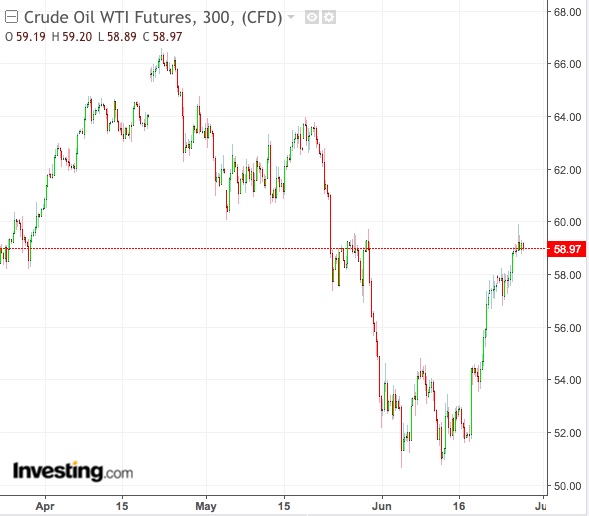Steady, oil bull!
In what could be a stupendous turnaround in most markets but is typical in oil, crude has gone from a bull market to bear and back to near bull in less than four weeks. And like its last two transitions, this one may not last.
That will be maddening to longs in crude who’ll want a summer-long rally to justify the demand common for fuels at this time of the year.
The truth is there are just too many counteracting forces in oil now, particularly on the global macro side, to offset even the best weekly data put out by the U.S. Energy Information Administration.
Speaking of that data, Wednesday’s regular release from the EIA could not have been more emphatic to oil bulls as the agency reported the biggest weekly crude inventory draw since September 2016. The drop of nearly 13 million barrels was four time above market expectations. That wasn’t all: gasoline stockpiles and inventories of distillates, which include products such as heating oil, gasoline and jet fuel, also fell versus forecasts for builds.
“Definitely a bullish surprise on all fronts,” Tariq Zahir, founder of the oil-focused Tyche Capital Advisors fund in New York, said, describing the data.
While he’s an oil bear, Zahir thinks West Texas Intermediate, the benchmark for U.S. crude, could breach $60 soon, having come within striking distance of that target on Wednesday.

In early Thursday trade in New York, WTI was less than $8 from recapturing the 2019 high of above $66 it hit in April. In just a week, both WTI and U.K. Brent recovered 10%—or half of what they lost over the five previous weeks—from an escalation of tensions over the U.S.-Iran sanctions spat. WTI now shows a 30% gain on the year. Gasoline, meanwhile, is up 45% on the year after the permanent closure of a fire-destroyed refinery in Philadelphia added to fuel shortage worries in the East Coast.
That’s the good stuff. Now, for the unsettling part.
G20 Next Big Act For Oil
Come Friday, global markets will be on the lookout for what could be the single largest event of the year: the G20 summit in Osaka, where U.S. President Donald Trump sits across his Chinese counterpart Xi Jinping to see if they can get back to where they left trade talks last December. Since their previous meeting, a steady escalation of tit-for-tat tariff measures has hurt businesses and markets on both sides, making the specter of a global recession look more real with each passing day.
Never known for his consistency, Trump has been sending out mixed signals on the likely outcome of the talks, from the time he tweeted a week ago that he had a “very good” phone call with Xi before they agreed on the Osaka date.
On Wednesday, Trump said a trade deal with China was possible but added that he was happy with the way things were and was still considering more tariffs on Beijing.
Trump Wavering On China Deal
The U.S. president has also spoken of an alternative plan that would involve reducing business ties with China.
Overall, this year the festering trade war between the world’s top two economies has been a major drag year on oil, which might have even surged beyond $80 a barrel otherwise.
Stephen Innes, managing partner at Vanguard Markets in Bangkok, told Reuters on Thursday:
"With Trump stirring up trade war dust via "Plan B", there is still that element of the unknown.”
"I think the length of the speculative positioning might be stretched too tight ahead of G20 and, of course, OPEC.”
Almost immediately after the G20 ends on Saturday, the 14 members of the Saudi-led Organization of the Petroleum Exporting Countries meet on Monday. A day later, the group will be joined by its 10 oil-producing allies led by Russia to talk about extending supply cuts that have been on since December.
While Saudi Arabia has grown increasingly dependable on Russia since the first ever OPEC+ production cuts collaboration in 2015, Moscow has each time appeared more reluctant to renew the deal. That’s partly because of push-back from Russian oil companies that feel Moscow is getting a lousy deal for helping out OPEC under the agreement. Igor Sechin, head of Russia’s Rosneft (OTC:OJSCY), the largest oil firm in the world, argued that by cutting production, the company is ceding market share to aggressive U.S. oil exporters eager to meet the needs of any underserved customer.
Russian Dilemma Over OPEC+
Sechin has absolute reasons to be worried about this. Within the EIA data released on Wednesday was an entry for U.S. crude exports showing shipments at a record 3.7 million barrels per day. This is likely to add to Sechin’s consternation and could weigh on the role Moscow is to play in the forthcoming round of the OPEC+—a decision ultimately in the hands of Russian President Vladimir Putin.
Putin will meet Saudi Crown Prince Mohammed Bin Salman, who calls the shots for his Kingdom on OPEC, at the G20. The elder Russian statesman supported Bin Salman even when many world leaders shunned him last year for his alleged involvement in the murder of Saudi-born journalist Jamal Khashoggi. But Putin also said in the past that Russia can live with $40 oil, unlike the Saudis who need prices at closer to $80 per barrel, according to estimates. In the face of increasing U.S. competition for exports and influence of Sechin—one of his closest advisors—there’s no telling how Putin will decide.
Energy Minister Alexander Novak, who represents Russia at the OPEC talks, also spoke in the past of his country’s dilemma in supporting OPEC.
Analysts say if OPEC+ fails to extend its previous agreed commitment to cut 1.2 million bpd of oil, crude prices could fall sharply.
Zahir said oil traders will be closely watching the G20 meeting and July 1-2 OPEC meetings:
“The next directional move on oil will be based on the results of these two events.”
